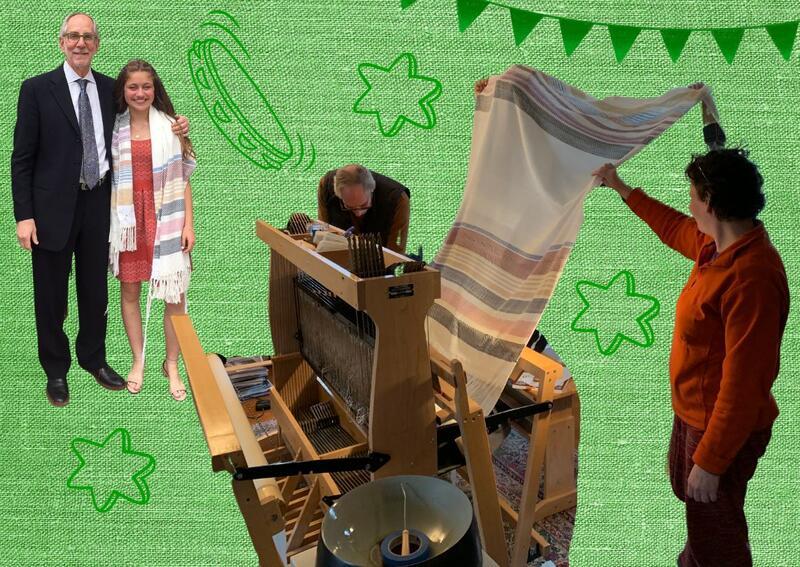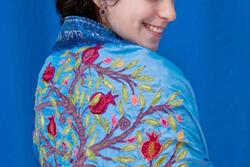Weaving My Asymmetrical Jewish Identity
After his retirement, my Great Uncle Joe found a new hobby: weaving. Not weaving as in the small cardboard looms where I had practiced going “in, out, in, out” as a little kid, but big, heavy floor looms that require you to engage your whole body–your weight to push down the pedals and your arms to throw the shuttle through the yarn openings–as you make your pattern come to life. Every year, for Thanksgiving break, my family drives to Minnesota, where my uncle lives. Since 2015, he has taught me how to weave on these giant looms one year at a time.
At first, he showed me the simple back-and-forth motion of weaving: “Push pedal 7, then slide the yarn through, push pedal 8, and slide it back. Simple as that. Back and forth, back and forth.” It’s one repetitive motion that creates the most recognizable weaving pattern: plain weave. Eventually, he brought in the other six foot pedals that develop complex patterns: “Push pedal 1 slide through, pedal 5 slide back, pedal 3 and 4 slide through...” The first year that he taught me about weaving, I made a freestyle tapestry. The pattern wasn’t the main focus, as I was exploring the different shapes that come from pressing different pedals. The next year, I followed a pattern in a book and wove four beautiful dish towels, and each year after, the patterns got more complex and the reward felt far better.
Before each Thanksgiving, my Uncle Joe lets me pick the type of weaving I want to make (tapestry, dishtowels, blanket, scarf, etc.), the patterns I want to explore, and the colors I want to use. The room in which his original loom lived is now just a giant vault of yarn, and the looms have taken over the living room! My uncle likes to joke that “some weavers collect looms and some collect yarn… I do both.”
In 2018, it became time to start thinking about my bat mitzvah, scheduled for 2019. My uncle had the idea that maybe I could weave a tallis of my own. I'll be the first to admit that initially, I was doubtful. Aside from whether or not I could do it, I didn’t think that it was something I wanted to do. In my mind, my tallis might not feel real if it wasn’t “regulation”—whatever that means. I didn’t want my handmade tallis to somehow invalidate my bat mitzvah. But upon further reflection, I realized how foolish that was, so I did it. I wove my bat mitzvah tallis in three days (with the help of my uncle, who generously set up the loom before I arrived)!
The planning leading up to that Thanksgiving was stressful. I wasn’t energized about making tallis decisions because, like I said, I was worried about “invalidating” my bat mitzvah. My bat mitzvah, which at this point was only in the initial planning phase, felt like a looming pressure that wouldn’t be relieved until moments after I stepped off the bimah. I wondered, “How can I make this tallis as close to what it is supposed to be like?” Feeling ashamed of thinking like that, I thought, “How can I make it seem like I’m not worried about the validity of my bat mitzvah by breaking tradition?” Once I realized that my way of thinking was backwards, I went all in. I wanted my tallis to be big and completely surround me. I wanted my tallis to be asymmetrical, because, as someone who hyperfixates on symmetry, I knew if I attempted to make it symmetrical I would never be satisfied. I made up the pattern as I went. With three years of weaving experience, I felt confident enough to trust my gut. With no pattern, all of the colors I wanted, and a giant 62” by 46” by 50” floor loom at my disposal, I began.
The task was daunting at first, but I knew that if I could pull this off it would all be worth it. I sat at that loom, upwards of seven hours per day, weaving, with nothing to do besides think. Isolated with only the loom in front of me, I had the opportunity to imagine what this tallis would mean for me. A prayer tallis is a garment that often looks the same everywhere you go. Not my tallis. As the tallis would probably be the only thing up on the bimah that I had control over, I knew that it was important for it to really represent me. My tallis and I would go through this entrance to Jewish adulthood at the same time together.
The final step in making my tallis ready for use was to tie on the tzitzit. During this part of the construction, I felt a spiritual connection to Judaism – the strings of the tzitzit tugging on my heart. Up until that point, my tallis was more of an art project, but tying on the tzitzit made it feel like both art and a tool for prayer. The garment became a vehicle that would lead me into the post-bat mitzvah side of Judaism. Despite my complete lack of experience, I was determined to tie on my tzitzit all by myself. I had no idea how one might go about tying tzitzit so I did what any self-respecting curious 12-year-old would do, and I turned to YouTube. As I referred to him later in my D’var Torah, “the dude from JewishPathways on YouTube” taught me all I needed to know about how to tie on the tzitzit. By saying the prayers associated with the act of tying the knots and wrapping the strings, I felt ready for this further exploration into Judaism. My tallis was complete, and I was excited to show it off on the bimah.
The tallis is my connection to Judaism. It is a web of community, tradition, innovation, faith, and family: words I use to describe my Judaism. Sitting at the loom, I watched the patterns emerge from bottom to top just as I now continue to watch my asymmetrical Jewish identity grow and change every day.
This piece was written as part of JWA’s Rising Voices Fellowship.








Incredibly moving. Deep sincere feelings shine through. (It made me feel as
good as listening to Cantor Azi Schwartz. ) it was wonderful seeing you the
other day. Your inner beauty is definitel showing outwardly. 💕
To have the insight at twelve that making something asymmetrical would relieve the pressure to make something perfect is astounding. Weaving your own beautiful Talit - even more so.
Looking forward to hearing more from this creative, deep thinker!